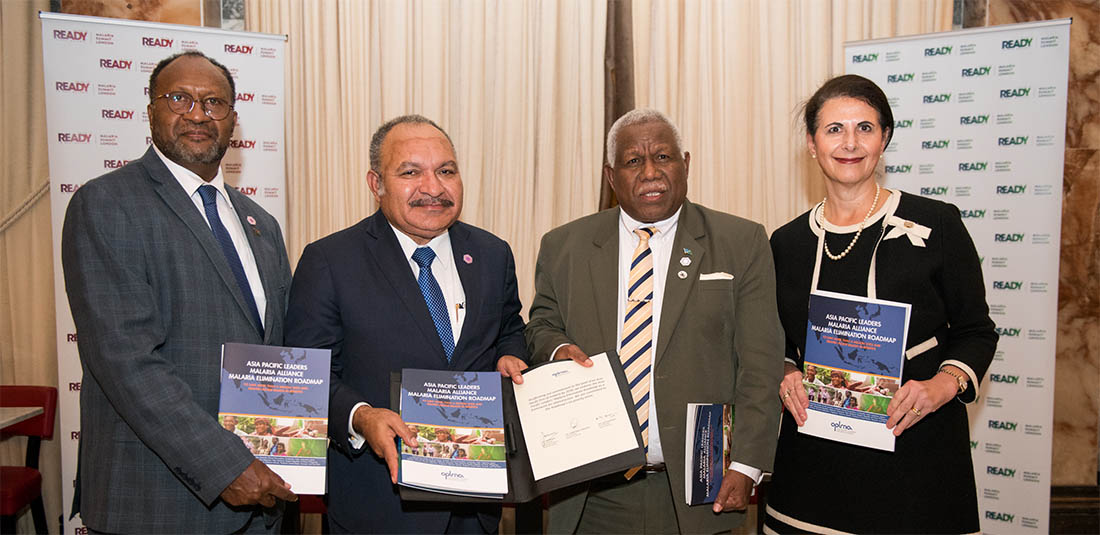
The Prime Ministers of Solomon Islands, PNG and Vanuatu, and the former Australian Minister for International Development and the Pacific (Credit: APLMA)
PNG’s nine-fold increase in malaria infections
By Stephen Howes
8 October 2018
A recent report from the PNG Institute of Medical Research (IMR) shows almost a nine-fold increase in the number of cases of malaria in PNG between 2014 and 2017. The key result of the report is that there has been “an increase in the size of the total population infected with malaria parasites from 50,309 in 2014 to 432,000 in 2017, representing an 8.6-fold increase.”
According to the April 2018 report, PNG Malaria indicator survey 2016-2017: malaria prevention, infection, and treatment, the national prevalence of malaria (the number of people infected divided by the total population at risk) is now 7.1%. (This figure is calculated only for those living in the lowlands, that is, at less than 1,600 m altitude. For climatic reasons, there is virtually no malaria in PNG’s highlands.) This is up from 5.1% in 2010/11 and a remarkably low 1% in 2014/15. In many ways, the 7% prevalence result underestimates the severity of the problem. The national figure is 10% for children under five. Malaria prevalence among all ages is as high as 16% in Madang, 10.8% in Milne Bay, 8.8% in East Sepik and 8.7% in New Ireland. For children under five years old, some of the reported provincial prevalence rates are terrifying: the highest is 20.5% in Sandaun.
What has gone wrong? We know from international research that “successes in malaria control can be fragile”. In the case of PNG, the report points to three factors: “a decline in Global Fund support” after 2013; “a simultaneous decline in PNG public expenditure in the health sector” and “a decrease in the availability of artemisinin-based combination treatment and RDTs across PNG, including extended stock-outs in many places.” In other words, less funding and fewer drugs. It’s pretty simple, though the report does also suggest that changes in mosquito biting behaviour (from the night to early evening) may have reduced the effectiveness of bed nets.
The earlier drastic reduction in malaria was held up as a PNG success story, as indeed it was. The reversal raises some very serious questions. These have to be directed first and foremost to the PNG government. The reduction in health funding and the rise in drug stock-outs is not something that has just happened to PNG because of a fall in resource prices. By greatly scaling up funds for MPs to spend on various projects, the PNG government has reduced funds for critical expenditures, funds that could have been used for malaria prevention and treatment. Our 2017 economic survey showed that health funding increased to 2014, but was sharply cut between 2014 and 2016, by 37% after inflation. Those responsible for the corrupt procurement of drugs must also take their share of the blame. The “free health” policy of the last five years has only made things worse.
There are also questions for Australia. We have set up the Asia Pacific Leaders Malaria Alliance and joined the End Malaria Council. We got PNG, Vanuatu and the Solomon Islands just a few months ago to commit “to the regional goal of ending the disease by 2030.” But the credibility of Australia’s leadership – not to mention such public statements – is completely undermined if malaria is rampant in our closest neighbour and former colony, and we are unwilling to underwrite the response.
Yet what exactly is Australia doing to combat malaria in PNG? Where is our leadership? The DFAT webpage on aid to PNG claims that “our efforts are continuing to make inroads against malaria and tuberculosis”, but in reality the focus is almost entirely on TB. We have only a tiny ($4 million) but high-profile project with China to improve malaria diagnosis.
The Global Fund website still claims that “PNG has reduced the number of malaria cases and deaths,” which was once true. The Global Fund continues to support the anti-malaria effort in PNG, albeit at a reduced level. A search of the Global Fund website yielded no documents evaluating its PNG program.
I know, from the experiences of friends and colleagues, that for many of the people of Papua New Guinea malaria is an ever-present threat, and an all-too-frequent reality. The resurgence of malaria and the re-emergence of polio are national tragedies. I hope that they serve as wake-up calls for the PNG government and donors alike.
About the author/s
Stephen Howes
Stephen Howes is Director of the Development Policy Centre and Professor of Economics at the Crawford School of Public Policy at The Australian National University.
